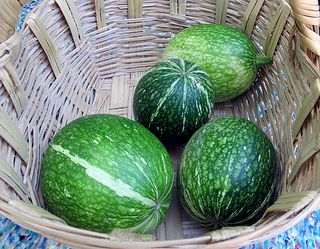
Organically grown chilacayote (fig leaf gourd, Cucurbita ficifolia), available at Mercado de 100. In Mexico, the chilacayote is used above all as a vegetable, but it is also often cooked with piloncillo and other sweetening ingredients and eaten as a candy or as a filling for breads or pastries.
The locavore movement began in the United States late in the 1960s at a time when people began to awaken to the notion that it would be healthier for themselves and the planet if their food were produced close to home rather than hundreds or thousands of miles from their kitchens. Today, more people believe that local food systems, often marketing organically-grown products, offer choices that are superior to those proferred by global corporate models. Within the last few years, the locavore movement has come to Mexico City.

This full-size bronze replica of Michelangelo's David gazes from the fountain in the lovely Plaza Rio de Janeiro in Mexico City's Colonia Roma Norte. The Mercado de 100 sets up in this plaza, at the corner of Calle Durango and Calle Orizaba, every other Sunday morning.
In years gone by, all the world consisted of locavores. Produce and meats were not flown or trucked from faraway farms to our supermarkets. We ate what was seasonal, and most often we ate we we ourselves produced. In many parts of Mexico, this is still true today. However, with the country-wide incursion of giant globalized supermarket chains such as Comercial Mexicana, Soriana, Chedraui, Wal-Mart, and others, more and more food is commercially produced and brought to market from enormous distances.

Artisanal breads at Mercado de 100, including crossaints and whole grain loaves produced by Mexico City's Pan 100.
In 2009, a group of friends in Mexico City were the startup group for the non-profit society that directs Mercado de 100. Concerned about the quality of food available in most supermarkets in the city, they believed (and continue to believe) that the population of this enormous metropolis deserves a choice: the opportunity to eat fresh, pesticide free, locally grown food.

Locally grown organic lettuce.
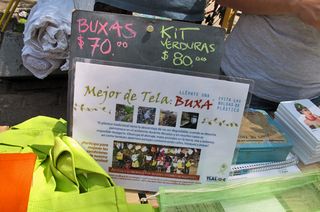
Need an ecological, re-useable market bag? These come in several sizes and terrific colors.
When Mercado el 100 started in 2009, it was peripatetic–moving from one location to another every time it set up. Today, it has a permanent spot at the lovely Plaza Rio de Janeiro, one of the most beautiful small parks in Mexico City. A visit to the market on a sunny Sunday morning can easily entice you to continue your day with a leisurely stroll around this part of Colonia Roma.
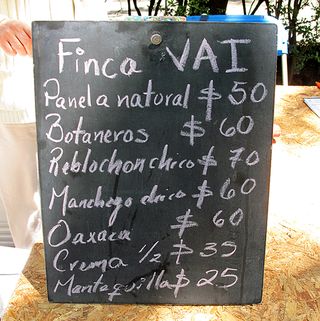
Menu of cheeses from Finca VAI in Querétaro. Mexico Cooks! tasted the manchego and the reblochon; both are delicious. One of these days soon we hope to visit Finca VAI for a tour of its operation.

From left to right, organically grown pears, apples, and tomatoes.
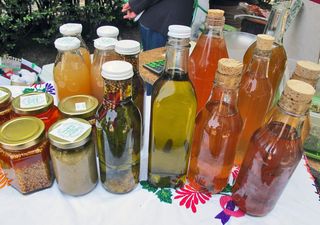
Locally bottled salsas and vinegars.

A bird-ish basket full of quail eggs. Mexico Cooks! likes to use them blended raw into a licuado (a thick fruit drink similar to a smoothie) or soft-poached, to garnish individual bowls of Chinese watercress and pork soup.
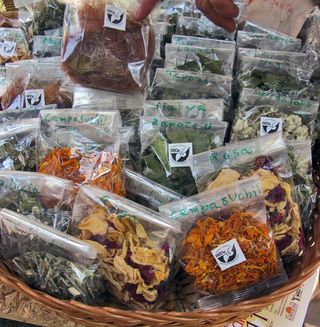
Herbs and spices, all organically grown (the label attests to that) and pesticide-free. The booth also offers delicious jams and honey. Mexico Cooks! brought home a cup of fresh raspberry jam and a bag of gordolobo (Gnaphalium Sp.), a medicinal flower which is brewed into a tea and used as an expectorant.
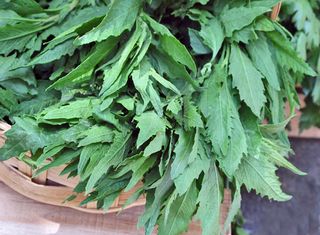
A basketful of fresh organic epazote (wormweed), ready for a long simmer in a pot of beans.
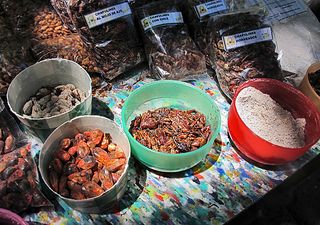
Pre-Hispanic era treats in today's Mexico: clockwise from bottom left, dried corn with powdered chile, dried corn with honey and pinole, chapulines (grasshoppers), and pinole.

Artisan-made, locally-produced soaps from Xamania, which also offers earth-friendly body lotions and cosmetics.
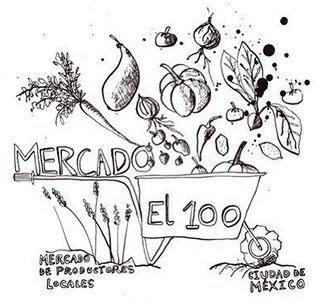
Mercado el 100, open every two weeks in Plaza Rio Janeiro (at the corner of Calle Durango and Orizaba), Colonia Roma Norte, Mexico City. Tell them their friends at Mexico Cooks! sent you.
Looking for a tailored-to-your-interests specialized tour in Mexico? Click here: Tours.
Disclaimer: Marca País-Imágen de México is a joint public and private sector initiative designed to help promote Mexico as a global business partner and an unrivaled tourist destination. This program is designed to shine a light on the Mexico that its people experience every day. Disclosure: I am being compensated for my work in creating content for the Mexico Today program. All stories, opinions, and passions for all things Mexico that I write on Mexico Cooks! are completely my own.
Leave a Reply